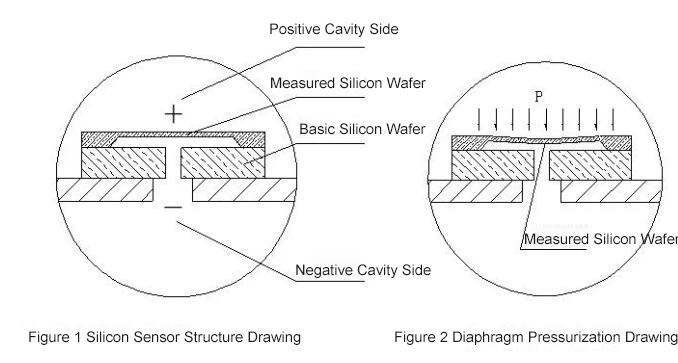Rocksensor's perspective: reliability design of silicon pressure sensor against overload (Part 1)
Abstract: in this paper, the overload protection of pressure sensor is realized through the structural design of silicon diaphragm and the external protection structure design of pressure sensor. For the differential pressure sensor performance of positive and negative double chamber and center overload protection diaphragm linkage protection design scheme, that is, when the overload pressure reaches the ultra-high differential pressure, the high-pressure side diaphragm and the matrix are bonded, and the low-pressure side diaphragm bulges out to prevent the ultra-high differential pressure from being transmitted into the sensor; for the gauge pressure and absolute pressure sensor, the design scheme of linkage between the measuring end and the overload protection diaphragm is presented, that is to say, when the overload pressure reaches the ultra-high differential pressure, the diaphragm at the high pressure side and the substrate Before the load pressure reaches the ultra-high pressure, the diaphragm at the measuring end is connected with the matrix, and the overload protection diaphragm bulges to prevent the transmission of ultra-high pressure into the sensor.
introduction:
The core of the silicon pressure sensor is the silicon diaphragm. When the pressure exceeds a certain proportion of the rated working pressure, it is easy to affect the measurement accuracy, and even rupture failure. In many measuring occasions, the error caused by human operation, or the abnormal pressure impact and fluctuation in the pressure pipeline are easy to produce pressure signals far beyond the test range of the pressure sensor, which makes the measuring silicon diaphragm in the state of pressure overload. The common pressure sensor has no overload protection function, so it is easy to damage the signal generator of the sensor in this case, which makes the sensor stop working. Therefore, how to effectively protect the reliable operation of silicon sensors in the field has attracted more and more attention of sensor manufacturers and users. The design method of overload protection for silicon pressure sensor can solve the above problems.

In Figure 1, the sensitive element of the silicon sensor diffuses p-type impurities onto the n-type silicon wafer to form an extremely thin conductive p-type layer. The lead wire is welded to form a "silicon strain gauge". Its electrical performance is to make a fully dynamic Wheatstone bridge with piezoresistive effect. The piezoresistive Wheatstone bridge is bonded to an elastic element (i.e., its n-type silicon substrate). The pressure of the medium is transmitted to the positive cavity side of the silicon diaphragm through the sealing silicone oil, and forms a pressure difference with the medium acting on the negative cavity side. The result of their joint action is that one side of the diaphragm is compressed and the other side is stretched. The pressure difference makes the bridge unbalanced and outputs a signal corresponding to the pressure change. The output signal of Wheatstone bridge is processed by the circuit, which produces 4-20madc standard signal output which is linear with pressure change.
In Fig. 2, under the action of the pressure difference between the positive and negative chambers, the measuring silicon diaphragm (i.e. elastic element) is deformed and bent. When the pressure difference P is less than the required stress proportional limit σ P of the measured silicon diaphragm, the bending can be reset; when the pressure difference p exceeds the required stress proportional limit σ P of the measuring silicon diaphragm, it will reach the yield stage of the material, or even the strengthening stage. At this time, the silicon is measured after the pressure difference is removed When the pressure difference P reaches or exceeds the maximum stress σ B that the silicon diaphragm can bear, the measuring silicon diaphragm will rupture, which will directly lead to the sensor damage. Therefore, the measurement accuracy and lifetime of the sensor can be effectively protected by preventing or weakening the overload differential pressure P directly transmitted to the measuring silicon diaphragm.